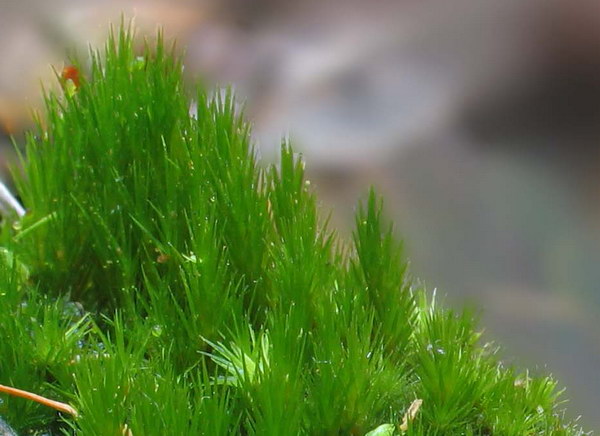
1 Robust, 2.5-15 cm. tall — 2
Small, 2 cm. tall or less —14
2 Leaves, at least at the shoot tips, strongly curved and turned to one side —3
Not so — 6
3 Leaves very long (the longest being 10-14 mm.), all sickle-shaped and very strongly turned to one side of shoot: chiefly in sheltered mountain woods — Dicranum majus
Leaves shorter (the longest 6-8 mm.), less strongly and regularly turned to one side; habitats various — 4
4 Stems thread-like; leaves (3-5 mm.) rather widely spaced and suddenly narrowed above base, drawn out to extremely fine points; calcicole — Ditrichum flexicaule
Stems stouter, often-much interwoven with tomentum; leaves (4-8 mm.) crowded and gradually narrowing from relatively broad bases (up to 1 mm.); habitats various — 5
5 Leaves much curled when dry; plant blackish below, dull olive-green above; exposed ground on mountains, bark of oak trees— Dicranum fuscescens
Leaves little altered when dry; plant brownish below and bright yellowish green above; very common in woods (especially base of trunks), on heaths, chalk downs, mountain ledges, etc. Leaves toothed in the top half, nerve reaches to the leaf tip and has toothed lamellae on the underside — Dicranum scoparium
6 Plants of marshes, bogs and wet places on moors — 7
Plants of some other habitat — 9
7 Leaves rather short (about 3 mm.), widely spreading in star-like fashion especially at shoot tips, giving 'bottle-brush' effect; basal angles of leaf not orange-brown. Moorland and mountains. Looks a bit like R. loreus but has dense rusty-brown tomentum on the stems and has a single nerve— Breutelia chrysocoma (= B. acurata)
Leaves longer (4-6 mm. usually), not widely spreading to give 'bottle-brush' effect; basal angles of leaf usually orange-brown — 8
8 Leaves bristle-like, held nearly erect both wet and dry; orange tomentum on stems seldom very obvious (but rust-coloured rhizoids). Nerve more than 1/3 the width of the leaf base. Woods and heath on sand. — Campylopus flexuosus
Leaves not bristle-like, spreading when wet, shrivelled and curled when dry; orange tomentum on stems very obvious; a common and characteristic species of these habitats — Aulacomnium palustre
9 Leaves much twisted and curled when dry — 10
Leaves little altered when dry — 11
10 Back of nerve and leaf base prominent and shining in dry state; leaf margin entire; very rarely fertile; strict calcicole — Tortella tortuosa (Ptychomitrium polyphyllum keys out here – abundantly fertile on siliceous rock)
Back of nerve and leaf base not as above; leaf margin finely toothed (just visible x 10); characteristic round capsules usually present; habitats various — Bartramia pomiformis
11 Leaves widely spreading to give shoot 'bottle-brush' effect; orange or red-brown tomentum on stems very obvious; wet mountain ledges — Breutelia chrysocoma
Leaves not as above; orange tomentum seldom obvious; habitats various — 12
12 Leaves with evident expanded 'blades'; and not having bristle-like tips — Straight-leaved forms of Dicranum scoparium
Leaves bristle-like, abruptly narrowed to form long fine tips — 13
13 Nerve excurrurent in strongly-toothed hair point, frequently pointing away from leaf blade — Campylopus introflexus
Other than above — 13a'
13a´ Leaves almost straight when wet and slightly flexuose when dry; orange-brown patches at basal angles of leaf; plant calcifuge — Campylopus flexuosus
Leaves markedly flexuose when wet and dry; no orange-brown patches; plant calcicole — Ditrichum flexicaule
14 Leaves strongly curled and twisted when dry; back of nerve and leaf base prominent and shining — Tortella tortuosa
Leaves at most lightly twisted when dry; back of nerve and leaf base not as above — 15
15 Leaves strongly curved and turned to one side — 16
Leaves straight or flexuose, spreading, not turned to one side — 17
16 Leafy shoots usually very short (often only 5-8 mm. tall), yellow-green; capsule erect, cylindrical, symmetrical — Ditrichum heteromallum
Shoots usually taller (1-2 cm.), mid-green; capsule inclined, curved and asymmetrical; very common on acid banks, etc. — Dicranella heteromalla (Cf. also very dwarf states of Dicranum scoparium.)
17 Leaves and shoot tips very fragile; plant forming low dark green patches covered with lighter green broken shoot tips and leaves; heaths and peaty places — Campylopus pyriformis (or small Campylopus introflexus, above)
Leaves and shoot tips not fragile; plants in short erect tufts; habitats various — 18
18 Red-brown patches at basal angles of leaves — Campylopus flexuosus (small forms)
Red-brown patches lacking — 19
19 Plants in short yellow-green tufts (a few millimetres);
capsule nearly spherical, cleistocarpous, sessile among bristle-like
perichaetial leaves — Pleuridium
subulatum or acuminatum
Plants taller (1-2 cm.), dark green; capsule pear-shaped, with peristome, on long seta — Leptobryum pyriforme

 |
For comments
about this site please mail to:
 (e-mail address given as graphic to avoid spam) |